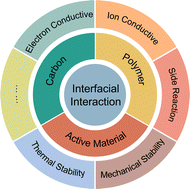Enhancing composite electrode performance: insights into interfacial interactions
Abstract
Propelled by the widespread adoption of portable electronic devices, electrochemical energy storage systems, particularly lithium-ion batteries (LIBs), have become ubiquitous in modern society. The electrode is the critical battery component, where intricate interactions between the materials govern both the energy output and the overall lifespan of the battery under operational conditions. However, the poor interfacial properties of traditional electrode materials fall short in meeting escalating performance demands. To facilitate the advent of next-generation lithium-ion batteries, attention must be devoted to the interfacial chemistry that dictates and modulates the various dynamic and transport processes across multiple length scales within the composite electrodes. Recent research has concentrated on systematically understanding the properties of distinct electrode components to engineer meticulously tailored electrode formulations. These are geared towards composite electrodes with heightened chemical stability, thermal robustness, enhanced local conductivities, and superior mechanical resilience. This review elucidates the latest advances in understanding the impact of interfacial interactions in achieving high-capacity, high-stability electrodes. Through comprehensive insights into the interfacial interactions between the various electrode components, we can create improved integrated systems that outperform those developed through empirical methods. In light of this, the adoption of a holistic approach to enhance the interactions among electrode materials becomes of paramount importance. This concerted effort ensures the attainment of heightened rate capability, facilitation of lithium-ion transport, and overall system stability throughout the entirety of the cyclic process.



 Please wait while we load your content...
Please wait while we load your content...